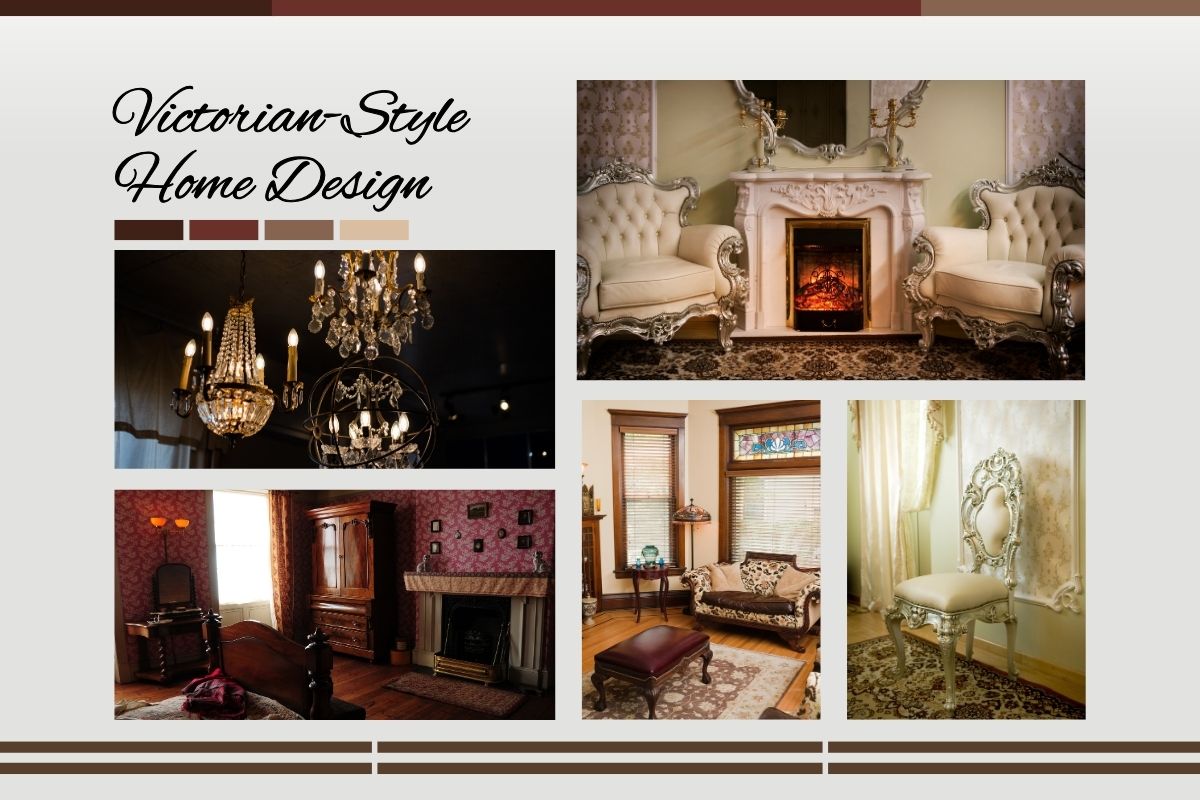Classic Beauty – Victorian-Style Home Design

Think of Victorian-era houses and you instantly conjure images of ornate trim, lofty ceilings, and an almost theatrical sense of drama in every nook and cranny. Named for Queen Victoria (who reigned from 1837 to 1901), this style isn’t just a single “look”—it’s a mashup of influences from Tudor, Gothic, Middle Eastern, and even Asian aesthetics, all thrown into the Victorian melting pot. In short, it’s one of those periods where people really wanted to show off—big time. Homeowners, interior designers, and historians alike still marvel at how creative (and, let’s be honest, a bit over-the-top) these houses can be.
If you wander into a Victorian home today, the first thing that often stops you in your tracks isn’t the furniture or the wallpaper—it’s the doors. Yep, those “simple” Victorian internal doors are usually mini works of art, complete with carvings, stained glass, and hardware that looks more Rococo than utilitarian. And because these doors literally frame each room, they set up expectations for what’s on the other side.
Table of Contents
ToggleWhy Doors Steal The Show In Victorian Homes
Ask anyone, “What’s the first thing you notice when entering a room?” and most will say, “The door!” Victorian architects knew this instinctively. Rather than hiding them, they turned doors into decorative centerpieces. Picture a pair of heavy oak doors with swirling floral carvings or a mahogany slab inset with jewel-toned stained glass—doors like these don’t just let you into a room; they give you a hint of the pageantry that awaits inside.
Back in the day, each room had a very strict purpose. You didn’t just wander into a “living room”; you entered a “parlor,” meant expressly for greeting guests. Then there was the “morning room” for breakfast, the “drawing room” for after-dinner chit-chat, and so on. Those doors weren’t merely functional—they reinforced boundaries, both visual and social. Today, while we’re more inclined to knock down walls for open-plan living, reintroducing a grand internal door here and there can instantly evoke that sense of formality and tradition.
A Quick History Lesson On Victorian Home Design
The Victorian period was a bit like a buffet of architectural styles. If Tudor pointed back to medieval England, Gothic whispered of cathedrals and gargoyles. Then someone said, “Hey, why not throw in some Moorish arches, a dash of Romanesque columns, and—why not—some Chinese latticework?” Voilà: a totally new aesthetic design was born. The result? Houses where you might find a pointed-arch window next to an elaborately carved front door, all under the same roof.
Why all this showiness? In part, it was about projecting wealth and status. As industrialization boomed, middle-class families suddenly had more disposable income, and they wanted to “keep up with the Joneses.” So homes got bigger, fancier, and, yes, more complicated. Each room was a stage set: mahogany furniture in one chamber, delicate porcelain vases in another, and heavy damask wallpaper everywhere you turned. If you wanted to impress visitors, you left no stylistic stone unturned.
Victorian Internal Doors: Key Features That Matter
1. Ornate Carvings And Decorative Details
Most Victorian doors are like canvases for woodworkers’ artistry. Imagine scrolling vines, tiny flower motifs, and even classical figures peeking out from the panels. If you run your fingers along the edges, you’ll feel those little ridges and grooves—evidence of hours spent by skilled hands carving each curve.
Maintenance Tip: Those delicate scrolls can gather dust faster than you’d think. A soft-bristled brush (think: old watercolor brush) will gently sweep away dirt. Once a year, rub a light coating of beeswax polish across the surface. Trust me, skip the silicone sprays—those gleaming finishes attract grime and can dull wood over time.
2. Glass Inserts (Stained, Etched, And Beyond)
Putting glass into doors wasn’t just about letting daylight in—it was about making a statement. Victorian glass ranges from jewel-like stained panes depicting floral patterns to frosted, etched designs that ensure privacy. When the sun hits those panes just right, you get little rainbows dancing on the floor.
Restoration Note: If you stumble upon a cracked panel in your old stained glass, resist the urge to swap it out for something modern. Instead, find a skilled glazier who can replicate the original beveling. That way, you maintain provenance and keep the door’s “soul” intact.
3. Deeply Recessed Panels
Many Victorian doors aren’t flat; they have multiple panels—sometimes four, sometimes more—each outlined with decorative moulding. Some even sneak in curved or arched panels, adding depth and intrigue. These aren’t just for show; they catch the light differently and cast subtle shadows, giving the door a dynamic, three-dimensional look.
Refinishing Advice: If those moulded panels start to look tired, grab a top-notch primer and pick a British Standard color to mimic a mid-Victorian palette—“Mahogany” (BS 08B 15) or “Deep Lead” (BS 18B 25) are popular choices. The right hue can instantly transport you back to 19th-century London.
4. Hardware That Speaks Volumes
A scratched, cheap doorknob simply won’t do. Instead, look for brass or cast-iron knobs and escutcheon plates featuring curly Rococo designs or classical motifs. Back then, hardware was as elaborate as the door itself—think of it as jewellery for your entryway.
5. Heavy-Duty Construction
These doors were built to last—not slapped together. Mahogany, oak, walnut: these aren’t just lofty buzzwords. They’re dense, durable woods that can endure generations. That heft you feel when opening a Victorian door? That’s the hallmark of genuine quality, not some flimsy MDF knockoff.
Merging Tradition With Today’s Innovations
If you’re hankering for that old-world charm but also care about sustainability (and maybe a smart-home knock-and-enter feature), you’re in luck. Several UK craftsmen now offer FSC-certified, moisture-resistant engineered woods that perfectly mimic mahogany or oak grain. You get the look without contributing to deforestation, and these doors won’t warp, even if you live somewhere perpetually damp, like Cornwall.
On the tech front, designers have started installing “smart” knobs that tuck fancy electronics behind a classic brass faceplate. Your guests see a beautifully aged knob; you see an electronic lock you can open with your smartphone or a quick fingerprint scan. Pretty neat, right?
Even the glass has gotten a modern upgrade: low-emissivity (Low-E) coatings block infrared heat. So in winter, you’re not losing precious warmth, and in summer, the interiors stay cooler. That means fewer shivers and less sweating—and lower energy bills to boot.
Regional Twists: From Scotland To Southern England
Every corner of the UK has its own spin on the Victorian standard:
- Northern England & Scotland: Oak is the go-to. Doors tend to be chunkier, more rustic, often with visible strap hinges that nod toward local blacksmith traditions.
- London & Southern England: Mahogany reigned supreme—finer grain, richer color. Here, you might also spot glazed fanlights perched above the doorframe, letting extra daylight spill into hallways.
- Coastal Counties (Cornwall, Kent): Because of maritime trade, you’ll occasionally see teak or pitch pine—a smart choice in salty, damp air because these woods resist rot better than oak.
If you’re restoring a period property, keep an eye on these regional cues. They’ll help you track down authentic materials and ensure your efforts feel true to place and time.
Bringing Victorian Doors Into Modern Homes
a. Custom (Bespoke) Options
A growing number of UK shops now craft bespoke Victorian doors using modern materials. Maybe genuine mahogany is way out of your budget—no problem. You can opt for cross-laminated timber or reclaimed barn wood that’s milled to show a similar grain pattern. Many of these contemporary substitutes also include built-in soundproofing or greater resistance to temperature swings. So you get the charm without compromising on comfort.
b. Salvaged Treasures
Want the real deal? Hunt down architectural salvage yards specializing in Victorian-era finds. You might score a pair of original doors plucked from a demolished manor house—just imagine the stories they could tell. Once you’ve got them home, a thorough sanding, refinishing, and hardware swap (to fresh brass or iron) can revive them back to their former glory.
c. Glass Upgrades
If you’re not ready to swap out doors entirely, you can retrofit your existing ones with Victorian-style stained or etched glass inserts. Floral swirls? Geometric patterns? Totally up to you. Pick colors and designs that nod to the period but still feel personalized to your tastes.
Final Thoughts: Why A Victorian Door Is More Than Just A Door
At the end of the day, choosing a Victorian-style internal door isn’t just about nostalgia. It’s a celebration of craftsmanship—a way to honor the artistry of centuries past. And with today’s eco-friendly materials and smart-home integrations. You don’t have to sacrifice modern performance for old-world beauty. Whether you go for a reclaimed oak behemoth or a custom-engineered composite that looks like walnut, the right door can instantly anchor your home in history while making it feel effortless to live in.
So next time you pass by a Victorian door with delicate scrollwork or gleaming stained glass, take a moment to appreciate the story it tells: of eras gone by, of master carpenters hunched over chisels, and of homeowners who believed that even the little things—like an internal door—deserved to be extraordinary.
Published by Carol Jones
My aim is to offer unique, useful, high-quality articles that our readers will love. Whether it is the latest trends, fashion, lifestyle, beauty , technology I offer it all View more posts







